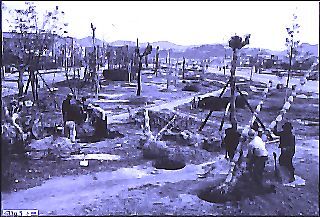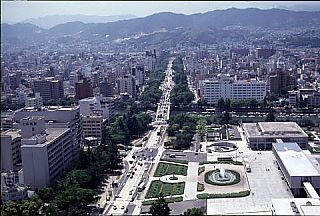A History of Greenery in Hiroshima
The greening of a city begins with planting and caring for those plants; it requires many years and dedicated care, and can only be realized with the understanding and cooperation of city residents.
This page will introduce how we brought greenery back to the city of Hiroshima post-war after it was turned into a burnt plain, and hopes to foster a deeper level of cooperation and understanding among residents about city greening efforts.
Pre-War Street Greenery
Hiroshima City, originally developed as a castle town, was home to many grand old residences. Beginning in the Meiji Era (1868-1912), as the city became a military city, many different military sites were also developed on the land, and the rich greenery which came with these sites could be seen throughout Hiroshima. This greenery, combined with the surrounding mountains and clear running waters of the Ōta-gawa River, made the city a truly beautiful place.
The Destructon of the Atomic Bombing
On August 6, 1945, a single atomic bomb fell on Hiroshima, burning houses and trees in the green city to the ground within a two kilometer radius from the hypocenter. Within a four kilometer radius, most houses were destroyed, and tree trunks were scorched by heat rays, losing branches and leaves to the blast. The city became a plain of gray, bereft of all things green.
The Return of Greenery
Having risen from the ashes, the City of Hiroshima began various projects to return the city to its former landscape and bring as many trees as possible to the burned plains. Our first step was to restore Hijiyama Park, which had been completely destroyed, through an erosion control project carried out with assistance from the Hiroshima prefectural government in 1948. The cherry blossom trees (Prunus yedoensis) planted there have grown tall and strong and are still enjoyed today.
Projects which involved lining the city streets with trees gained momentum around 1950, and the city began to create unique boulevards on each road which were lined with different trees. Examples of this include the rows of crape myrle along the road from Aioi-bashi Bridge to Kamiya-cho, the cherry blossom boulevard in Kyōbashi-cho, the wingnut trees along Namiki-dōri, the sweetgum trees in Ushita-cho, and the trident maple trees along Moto-machi. However some of these trees proved unsuited to the soil and others were unable to adapt to the rapid urbanization which ensued; in the end, only some of those tree-lined streets remain today.
From 1957 to 1958, the Hiroshima 20 Years in the Future project, a city-wide tree provision project, was carried out, complete with tree planting along Peace Boulevard, in Peace Memorial Park, and in Chūō Park with the help of city residents, as well as residents from 23 towns in four neighboring counties. Some 1,200 trees were donated to the green zones along Peace Boulevard in 1957, and in 1958, some 1,300 trees were donated, along with a number of smaller shrubs and bushes.

These trees, which have taken root and grown beautifully, are the centerpieces of the lush greenery along Peace Boulevard today. They provide shade in the summertime, take the edge off the gloom of winter, bringing joy to residents and visitors alike in all seasons.

Inquiries regarding this page
Flowers and Greenery Policy Section, Landscape Division, Greenery Promotion Department, Urban Development Bureau
1-6-34 Kokutaiji-machi, Naka-ku, Hiroshima
Tel: 082-504-2396 / Fax: 082-504-2391
Mail: [email protected]
